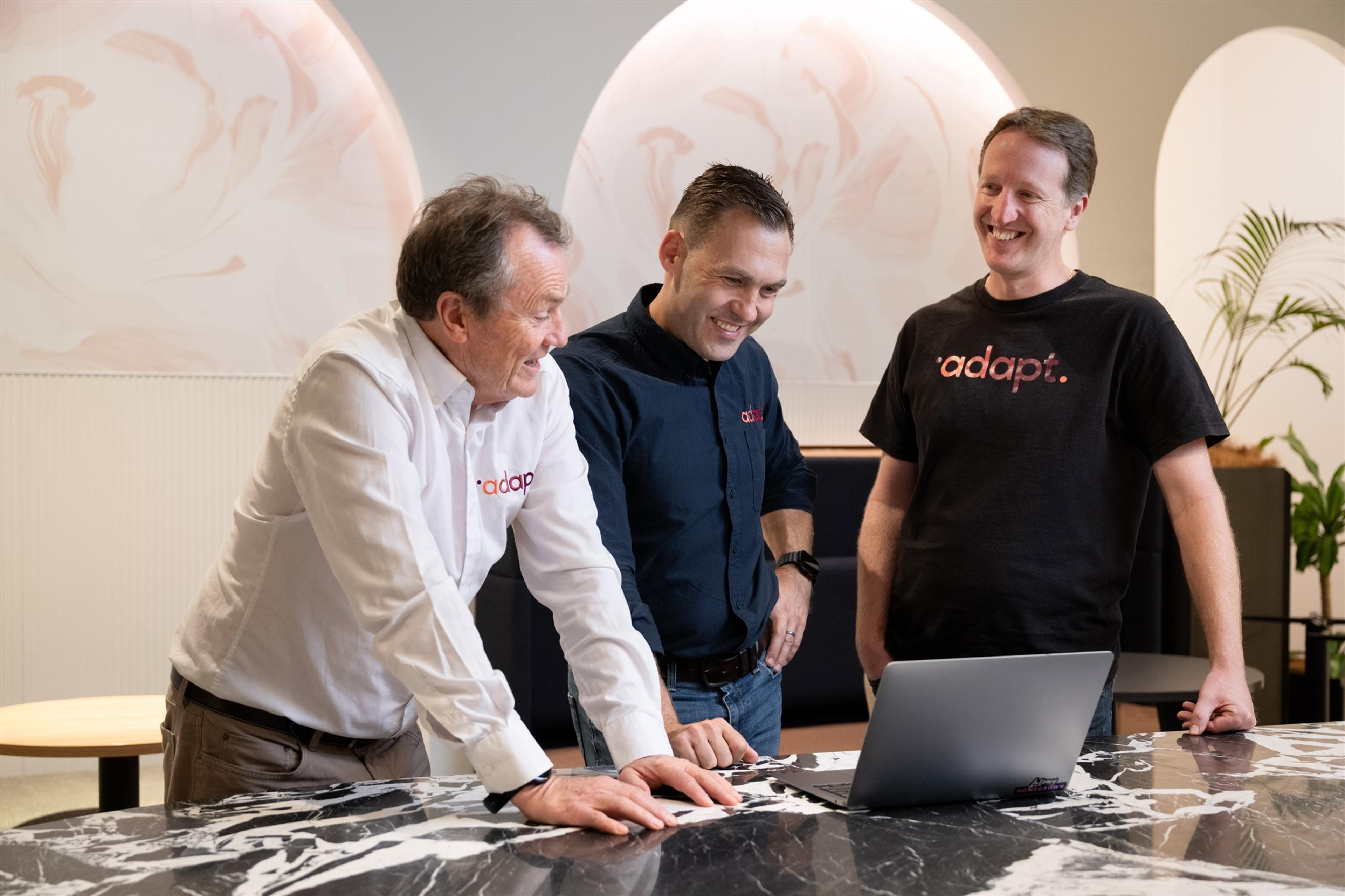The SME Owner's Freedom Formula: Succession Thinking vs Being Stuck in Operations

Many SME owners find themselves trapped in the daily grind of running their business, unable to step back without causing disruption. They are involved in every decision, oversee all operations, and often struggle to scale because their business depends entirely on them. While this hands-on approach may work in the early stages, it becomes a significant bottleneck to growth and long-term sustainability.
This is where Succession Thinking™ comes in. Unlike traditional succession planning, which focuses on exit strategies, Succession Thinking™ is an ongoing approach to creating business systems, empowering leadership, and ensuring long-term resilience. It allows business owners to step back from daily operations without sacrificing performance or value.
A business built with Succession Thinking™ is more valuable, scalable, and resilient. Investors and buyers prefer companies that function independently of their founders, making them easier to sell or transition to new leadership. Owners who embrace this approach gain more freedom, reduced stress, and time to focus on strategic growth.
This article explores:
- The operational struggles SME owners face.
- How Succession Thinking™ differs from traditional planning.
- The five principles of Succession Thinking™.
- The role of business systems in reducing owner dependency.
- The financial, operational, and personal benefits of implementing succession thinking.
By the end, SME owners will understand how to break free from operational dependencies and build a business that prospers beyond them.
The Operational Struggles of SME Owners
Many SME owners start their business with a hands-on approach, believing their direct involvement in every aspect of operations is necessary for success. While this may work in the early stages, over time, this level of control becomes a major bottleneck. Owners find themselves overwhelmed, unable to scale, and struggling to take time away from the business. This dependence on the owner ultimately limits business growth, reduces valuation, and increases the risk of burnout.
The burden of wearing too many hats
SME owners often play multiple roles—CEO, manager, sales lead, and operational strategist—all at once. While this involvement gives them control, it also creates inefficiencies that hinder growth, scalability, and strategic decision-making.
- Limited time for strategy – Owners become consumed by daily tasks like customer service, payroll, and troubleshooting. As a result, there is little time to focus on high-level strategic initiatives that drive long-term success.
- Decision-making bottlenecks – Employees and managers rely too heavily on the owner for approvals, problem-solving, and direction. This creates slow response times, operational delays, and unnecessary stress.
- Scalability challenges – Expansion is difficult when a business depends on one person. The owner becomes a single point of failure, making it impossible to delegate responsibilities effectively and limiting the company’s ability to grow.
This over-involvement means the business remains stuck in a survival cycle rather than sustainable growth. Owners who cannot step away for extended periods often feel exhausted yet trapped because the company cannot function without them.
The loneliness of leadership
Many SME owners hesitate to delegate or share decision-making responsibilities. This reluctance is often due to:
- A lack of trust in their employees' ability to execute tasks effectively.
- An absence of structured business systems that maintain consistency and accountability.
- Fear of losing control, believing only they can maintain quality and efficiency.
However, this mindset leads to:
- Micromanagement – When owners remain deeply involved in every detail, it stifles leadership development within the team. Employees become dependent on the owner instead of developing their own decision-making capabilities.
- Lack of future leadership – Without structured leadership development programs, there is no clear path for employees to take on higher responsibilities. When the owner is the only key leader, the business has no succession plan.
- Stagnation – Growth stalls because no one else has the authority to lead, innovate, or execute independently. The business remains stuck in daily firefighting instead of long-term strategy and expansion.
Why this model is unsustainable
A business that cannot function without its owner is not just difficult to manage—it is inherently risky, less valuable, and vulnerable to failure. An owner-dependent business faces several long-term consequences:
- Value depreciation – Investors and potential buyers seek businesses with structured leadership and independent operations. A company overly reliant on one individual is much harder to sell.
- Stagnation – Without leadership delegation and operational autonomy, companies struggle to scale or evolve. Businesses that fail to empower their teams become stuck in repetitive cycles of inefficiency.
- High failure rates – Many SMEs fail due to a lack of structured succession planning when unexpected circumstances force the owner to step away—whether due to illness, burnout, or external factors—the business often collapses because there is no established leadership pipeline.
Without Succession Thinking™, SME owners will always remain stuck in operations, unable to take a step back without compromising business performance. This limits the company's potential and traps owners in an exhausting and unsustainable work model. Implementing Succession Thinking™, leadership development, and structured business systems is the key to breaking free from this cycle and building a resilient, scalable company.
Understanding Succession Thinking™
For many SME owners, the idea of succession planning is often associated with retirement or selling the business. Waiting until an exit event to prepare for a leadership transition is a risky and outdated approach. Succession Thinking™ is a far more effective strategy—one that keeps the business independent, resilient, and valuable at all times rather than just at the point of transition.

How Succession Thinking™ differs from traditional succession planning
Traditional succession planning is typically reactive, which is only implemented when an owner is preparing to step away. This last-minute approach can lead to:
- Rushed transitions – Without structured leadership development, the new leadership team may not be fully prepared to take over.
- Instability – When employees, clients, and stakeholders suddenly experience leadership shifts, it can create uncertainty and disruption.
- Reduced business value – Potential buyers and investors see greater risk in businesses without a strong, self-sustaining leadership structure.
In contrast, Succession Thinking™ is a continuous process embedded into the business model from day one. Instead of viewing leadership transition as a single event, succession thinking creates an ongoing framework for leadership development, operational systemisation, and cultural continuity. This means that no matter when an owner chooses to step back—temporarily or permanently—the business remains stable and profitable.
Succession Thinking™ is about building a company that continues to succeed beyond the founder’s direct involvement. It allows SME owners to step back from day-to-day operations without negatively impacting business performance.
The Five Principles of Succession Thinking™
At the heart of Succession Thinking™ are five key principles that make businesses scalable, sustainable, and leadership-driven.
1. Seek Role Clarity
A common challenge in SMEs is that the owner wears too many hats, blurring the lines between leadership, strategy, and daily execution. Without clearly defined roles, employees struggle to take ownership, and the business becomes dependent on the founder.
How to implement:
- Define the distinction between owner, director, and operational roles.
- Create accountability structures that make employees aware of their responsibilities.
- Develop an organisational chart that outlines leadership roles and reporting structures.
2. Build Your Owners’ Vision
Many SME owners operate without a clear long-term vision, making it difficult to align decision-making with strategic goals. Without a strong vision, businesses tend to react rather than proactively plan for growth.
How to implement:
- Define a core vision and values that guide the company’s direction.
- Align strategic decision-making with long-term business objectives.
- Involve key stakeholders and leadership teams in refining and implementing the vision.
3. Build Leadership Beyond You
A business cannot grow or sustain itself if all leadership authority is concentrated in one person. Without a structured leadership pipeline, businesses risk stagnation and instability when the founder steps away.
How to implement:
- Identify and develop future leaders within the organisation.
- Implement mentorship, coaching, and leadership training programs.
- Encourage distributed leadership, where decision-making is shared across the organisation.
4. Build Culture Beyond You
A strong company culture provides continuity and stability even when leadership changes occur. When values are deeply embedded in daily operations, employees remain aligned with the company’s mission, ensuring smooth transitions.
How to implement:
- Develop a values constitution that defines expected behaviours and company culture.
- Incorporate cultural leadership into onboarding, training, and daily business operations.
- Recognise and reward employees who embody the company’s values.
5. Build Your Business Way
A business that lacks documented systems and structured processes struggles with inconsistency and inefficiency. Without a clear business model, leadership transitions become chaotic, and operational stability is compromised.
How to implement:
- Develop Standard Operating Procedures (SOPs) to promote consistency across all departments.
- Implement decision-making frameworks to guide teams in problem-solving without owner involvement.
- Leverage technology and automation to streamline repetitive tasks and improve efficiency.
Why These Principles Matter
By applying these five principles, SME owners can step back without disrupting the business, ensuring that operations run smoothly with or without their direct involvement.
This approach:
- Improves business continuity – Leadership transitions become seamless rather than disruptive.
- Increases business valuation – Investors and buyers prefer businesses with structured leadership and systemised operations.
- Enhances scalability – A well-documented, leadership-driven business can grow sustainably without depending on one individual.
Succession Thinking™ is the key to long-term business success. It allows SME owners to build a resilient, scalable, and independent business, providing the freedom to step back, expand, or exit on their own terms.
The Business Systems That Support Succession Thinking™
For SMEs to transition from owner-dependent to self-sustaining, they need structured business systems that provide efficiency, consistency, and scalability. These systems make sure that key processes do not rely on a single individual, allowing the business to function smoothly regardless of leadership transitions. Without them, owners remain trapped in daily operations, and decision-making becomes slow, inconsistent, and prone to bottlenecks.
By implementing well-defined business systems, SME owners can create a structured, resilient, and scalable organisation that succeeds beyond the founder’s direct involvement.
What are business systems?
A business system is a structured process, workflow, or framework designed to streamline operations and guarantee consistent execution. Business systems create predictability by standardising how tasks are performed, decisions are made, and knowledge is transferred across the organisation.
Without these systems, businesses rely too heavily on individual expertise rather than documented processes, making them vulnerable when key people leave. Systems reduce risk, improve efficiency, and create a foundation for long-term business continuity.
Key business systems for owner independence
To successfully implement Succession Thinking™ , SME owners need three core business systems that support leadership development, operational efficiency, and knowledge management.
1. Leadership Systems
Without a clear leadership structure, business owners become the primary decision-makers, causing bottlenecks and delays. A leadership system guarantees well-defined roles and responsibilities, allowing for distributed leadership and faster decision-making.
How to Implement:
- Create an organisational structure that defines leadership roles at all levels.
- Establish decision-making protocols that empower leaders to act without needing constant approval.
- Implement a leadership development program to prepare future decision-makers.
A strong leadership system reduces dependency on the owner and builds a pipeline of leaders ready to step into key roles when needed.
2. Operational Systems
A lack of structured processes for core business functions leads to inefficiencies, miscommunication, and inconsistent results. Operational systems standardise these functions, ensuring that daily business activities run smoothly regardless of who is in charge.
Key operational systems include:
- Sales & Marketing Processes – Defining lead generation, conversion, and customer acquisition strategies.
- Financial Management – Standardising accounting, payroll, and cash flow management to maintain financial stability.
- HR & Employee Development – Creating structured recruitment, onboarding, and performance management systems.
- Customer Service Frameworks – Setting response times, service protocols, and client interaction guidelines.
By implementing operational systems, businesses can maintain efficiency, reduce errors, and improve service consistency without relying on the owner’s direct involvement.
3. Knowledge Management Systems
A business that depends on undocumented knowledge is highly vulnerable. Without formal documentation, critical business information remains locked in the minds of key individuals, creating long-term risks when employees or the owner steps away. Knowledge management systems guarantee that expertise is transferred, retained, and accessible at all times.
How to Implement:
- Develop Standard Operating Procedures (SOPs) for key tasks and workflows.
- Create a digital knowledge base containing guides, templates, and best practices.
- Implement training programs that make sure employees understand and can apply documented processes.
With a robust knowledge management system, businesses eliminate knowledge gaps, reduce training time for new employees, and maintain long-term operational consistency.
The Power of Business Systems in Succession Thinking™
By integrating leadership, operational, and knowledge systems, SME owners can:
- Reduce bottlenecks – Empower teams to operate independently.
- Improve efficiency – Standardised processes eliminate confusion and errors.
- Enhance scalability – A structured business can grow without constant owner involvement.
With the right business systems, owners can step back with confidence, knowing that their company will run efficiently, retain its value, and sustain long-term success.
The Business Benefits of Succession Thinking™
Succession Thinking™ focuses on creating a business that is independent, scalable, and resilient rather than simply preparing for an exit. Businesses that rely too heavily on their owners struggle to grow, attract investment, or transition leadership smoothly. By embedding structured leadership, operational systems, and cultural continuity, SME owners can increase business value, improve efficiency, and gain personal freedom.
The benefits of Succession Thinking™ fall into three key areas: financial, operational, and personal.
Financial Benefits
A business that operates independently of its founder is far more attractive to investors, buyers, and strategic partners. A well-structured, systemised company reduces risk, making securing funding, partnerships, and long-term growth opportunities easier.
1. Increased business valuation
One of the biggest financial advantages of Succession Thinking™ is that it increases the business’s market value. Investors and buyers prefer businesses that can function without the owner's direct involvement. Companies with a structured leadership team, clear processes, and a succession framework are far more attractive than businesses where the owner is essential to daily operations.
A business that can run itself is more valuable and easier to sell or transition when the time comes.
2. Scalability and growth potential
Systemised businesses are more scalable because they do not rely on one person for decision-making or execution. Companies that invest in leadership development and documented processes can expand faster, attract investors, and form strategic partnerships.
Scalability is critical for securing:
- Funding from investors and banks, as a structured business, presents lower risks.
- New business opportunities, as leadership teams can focus on expansion rather than daily tasks.
- Smoother transitions, as business continuity is assured even when leadership changes.
3. More predictable revenue and stability
A structured business has more consistent revenue streams because it is built on defined systems rather than personal relationships or ad-hoc decisions. When processes are well-documented, and leadership is distributed, the company can navigate economic changes more effectively, reducing financial volatility.
Operational benefits
Beyond financial value, Succession Thinking™ improves efficiency, reduces bottlenecks, and supports long-term business stability.
1. Eliminates decision making bottlenecks
When SME owners retain all decision-making authority, operations slow down. Employees must wait for approvals, and innovation is stifled. By delegating leadership responsibilities, companies empower teams to make decisions quickly, improving response times and overall efficiency.
2. Improves efficiency and reduces errors
A business that relies on structured systems and processes operates more efficiently than one dependent on its founder’s experience and intuition. Systemisation provides:
- Consistent execution of tasks and services across the company.
- Reduced reliance on specific individuals, ensuring continuity even during staff turnover.
- Lower error rates, as standard operating procedures (SOPs) eliminate guesswork.
3. Supports long-term stability
A business built on Succession Thinking™ is more resilient in the face of change. Whether dealing with leadership transitions, market shifts, or unexpected challenges, companies with structured leadership and systemised operations can adapt without major disruptions.
Business continuity no longer depends on the owner’s availability, allowing the company to remain competitive in the long run.
Personal benefits for the owner
Beyond financial and operational advantages, Succession Thinking™ dramatically improves the owner’s quality of life. Many SME owners experience burnout, stress, and frustration because they cannot step away from daily operations. By implementing leadership delegation and structured processes, they gain greater freedom, flexibility, and peace of mind.
1. More freedom and flexibility
Owners who build a self-sustaining business can step back from daily operations without affecting performance. Whether they want to take vacations, focus on new ventures, or eventually transition out of the company, succession thinking makes this possible.
A well-structured company allows owners to work on the business rather than in it, allowing them to take a more strategic role.
2. Less stress and reduced workload
When leadership is distributed, and processes are documented, owners no longer have to micromanage every aspect of the business. Leadership teams share responsibilities, reducing stress and allowing the owner to focus on higher-level strategy and decision-making.
3. Time for strategic growth and innovation
With less involvement in daily operations, business owners gain the mental space and time to focus on long-term goals. Whether expanding into new markets, launching new products, or developing partnerships, Succession Thinking™ allows them to pursue opportunities that drive growth.
The Bottom Line
Succession Thinking™ is not just about preparing for an exit—it’s about creating a business that flourishes beyond the owner. By implementing structured leadership, systemised processes, and cultural continuity, SME owners can:
- Increase business valuation and attract investors.
- Improve operational efficiency and eliminate bottlenecks.
- Reduce stress and gain more personal freedom.
The result is a sustainable, scalable, and resilient business that offers the owner financial security, long-term stability, and a better quality of life.
For many SME owners, the ability to step back from daily operations without compromising business performance feels out of reach. Succession Thinking™ provides a clear, structured approach to breaking free from owner dependency and creating a business that flourishes beyond the founder.
By implementing leadership development, business systems, and structured decision-making, SME owners can build a scalable, valuable, and sustainable company. Businesses that rely too heavily on their owners struggle to grow, attract investment, and transition successfully. Succession Thinking™ eliminates these challenges by ensuring that leadership, culture, and operations remain stable and effective, regardless of who is in charge.
This proactive approach increases business valuation and operational efficiency and gives owners greater freedom, less stress, and the ability to focus on long-term strategy rather than day-to-day firefighting.
Actionable next steps
Implementing Succession Thinking™ doesn’t have to be overwhelming. SME owners can start with small but impactful steps that lay the foundation for long-term success.
- Start small – Begin by defining roles, documenting processes, and gradually delegating leadership. This will help transition decision-making away from the owner and empower the team.
- Invest in business systems – Implement structured processes, workflows, and automation tools to reduce reliance on the owner and increase efficiency.
- Develop a leadership pipeline – Train and mentor future leaders to take on key responsibilities, ensuring smooth transitions and a resilient leadership structure.
Succession Thinking™ requires a strategic, structured approach, and expert guidance can make the process seamless.
Learn how adapt can help you to discover how to build a self-sufficient business that can scale and prosper beyond the founder. Connect with us today.
By taking action now, SME owners can future-proof their businesses, enhance their value, and gain the freedom to focus on what truly matters—expansion, innovation, or simply enjoying the rewards of their hard work.




